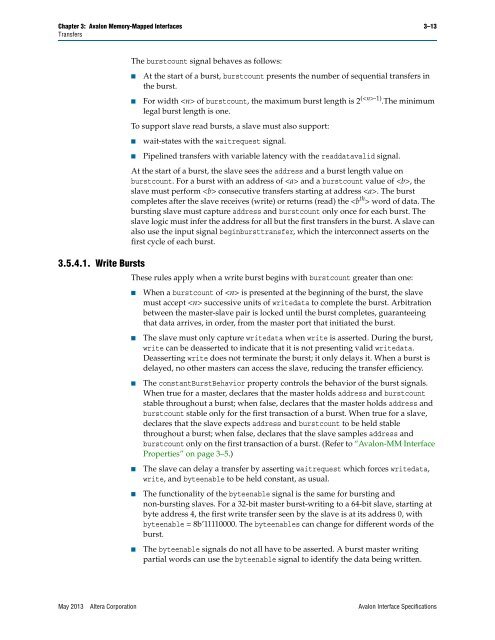Avalon Interface Specifications (PDF) - Altera
Avalon Interface Specifications (PDF) - Altera
Avalon Interface Specifications (PDF) - Altera
Create successful ePaper yourself
Turn your PDF publications into a flip-book with our unique Google optimized e-Paper software.
Chapter 3: <strong>Avalon</strong> Memory-Mapped <strong>Interface</strong>s 3–13<br />
Transfers<br />
3.5.4.1. Write Bursts<br />
The burstcount signal behaves as follows:<br />
■ At the start of a burst, burstcount presents the number of sequential transfers in<br />
the burst.<br />
■ For width of burstcount, the maximum burst length is 2 (-1) .The minimum<br />
legal burst length is one.<br />
To support slave read bursts, a slave must also support:<br />
■ wait-states with the waitrequest signal.<br />
■ Pipelined transfers with variable latency with the readdatavalid signal.<br />
At the start of a burst, the slave sees the address and a burst length value on<br />
burstcount. For a burst with an address of and a burstcount value of , the<br />
slave must perform consecutive transfers starting at address . The burst<br />
completes after the slave receives (write) or returns (read) the word of data. The<br />
bursting slave must capture address and burstcount only once for each burst. The<br />
slave logic must infer the address for all but the first transfers in the burst. A slave can<br />
also use the input signal beginbursttransfer, which the interconnect asserts on the<br />
first cycle of each burst.<br />
These rules apply when a write burst begins with burstcount greater than one:<br />
■ When a burstcount of is presented at the beginning of the burst, the slave<br />
must accept successive units of writedata to complete the burst. Arbitration<br />
between the master-slave pair is locked until the burst completes, guaranteeing<br />
that data arrives, in order, from the master port that initiated the burst.<br />
■ The slave must only capture writedata when write is asserted. During the burst,<br />
write can be deasserted to indicate that it is not presenting valid writedata.<br />
Deasserting write does not terminate the burst; it only delays it. When a burst is<br />
delayed, no other masters can access the slave, reducing the transfer efficiency.<br />
■ The constantBurstBehavior property controls the behavior of the burst signals.<br />
When true for a master, declares that the master holds address and burstcount<br />
stable throughout a burst; when false, declares that the master holds address and<br />
burstcount stable only for the first transaction of a burst. When true for a slave,<br />
declares that the slave expects address and burstcount to be held stable<br />
throughout a burst; when false, declares that the slave samples address and<br />
burstcount only on the first transaction of a burst. (Refer to “<strong>Avalon</strong>-MM <strong>Interface</strong><br />
Properties” on page 3–5.)<br />
■ The slave can delay a transfer by asserting waitrequest which forces writedata,<br />
write, and byteenable to be held constant, as usual.<br />
■ The functionality of the byteenable signal is the same for bursting and<br />
non-bursting slaves. For a 32-bit master burst-writing to a 64-bit slave, starting at<br />
byte address 4, the first write transfer seen by the slave is at its address 0, with<br />
byteenable = 8b’11110000. The byteenables can change for different words of the<br />
burst.<br />
■ The byteenable signals do not all have to be asserted. A burst master writing<br />
partial words can use the byteenable signal to identify the data being written.<br />
May 2013 <strong>Altera</strong> Corporation <strong>Avalon</strong> <strong>Interface</strong> <strong>Specifications</strong>
















